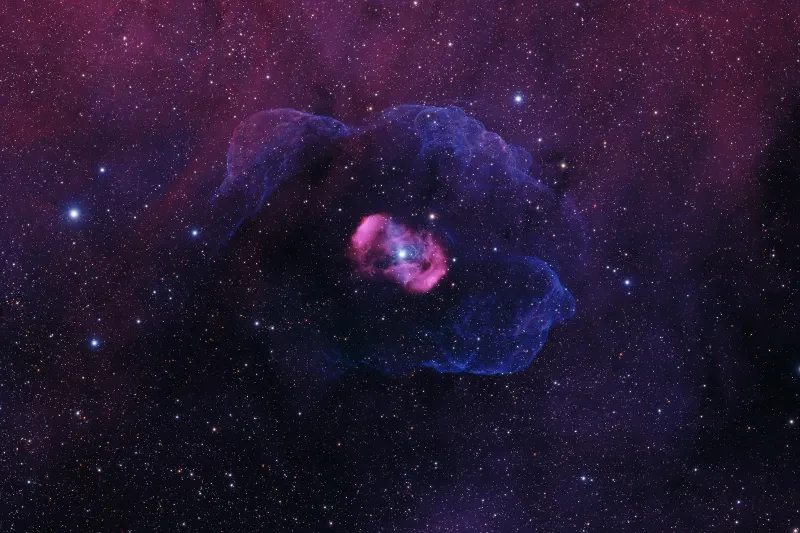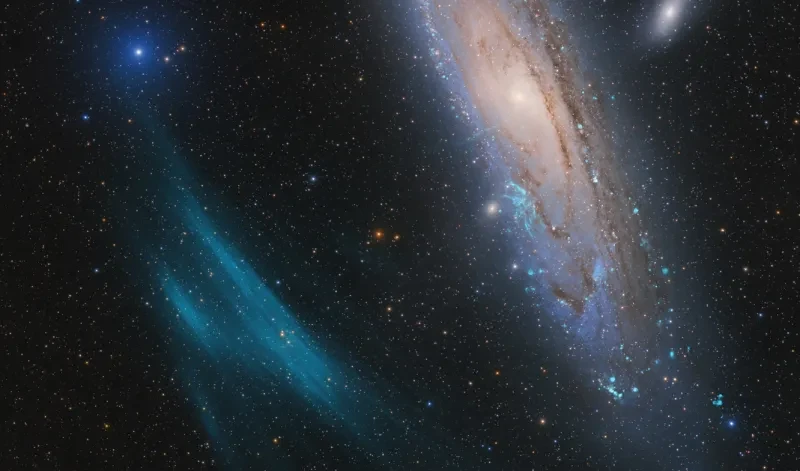
The winner of Astronomy Photographer of the Year 2023 has been revealed.
The spellbinding winning images from the world's biggest space photography competition were announced during an online awards ceremony on Thursday 14 September.
As well as the overall winner, there were 11 different category prizes up for grabs, from glittering galaxies and shimmering aurorae to out-of-this-world skyscapes. Find out more about all the entries below.
The Astronomy Photographer of the Year exhibition, where the winning images are on display, is now open. Visit the National Maritime Museum, and see the world's greatest space photography.

The winning photographers
Marcel Drechsler, Xavier Strottner and Yann Sainty have together been named the overall winners of Astronomy Photographer of the Year 2023 for their mysterious deep space photograph, Andromeda, Unexpected.
Why 'Unexpected'? Well, it has something to do with the hazy blue cloud you can see in the bottom left of the image.
The Andromeda galaxy is the closest spiral galaxy to our own Milky Way, and one of the most photographed deep-sky objects. Yet this particular photo, captured by an international trio of amateur astronomers, revealed a feature that had never been seen before: a huge plasma arc, stretching out across space right next to the Andromeda galaxy.
"Scientists are now investigating the newly discovered giant in a transnational collaboration," explain the photographers. "It could be the largest such structure nearest to us in the Universe."
The new discovery underlines how even the most 'familiar' parts of the Universe still contain countless mysteries. And for competition judge László Francsics, it underlines the importance of astrophotography to modern space science.
"What does a discovery image look like? It is mostly a blurry black and white image that depicts an almost invisible faint dot or a spectrum that is incomprehensible to us," he says. "However, this was not the case this time. This astrophoto is as spectacular as it is valuable. It not only presents Andromeda in a new way, but also raises the quality of astrophotography to a new level."
Find out more about the winning image
See the full Galaxies shortlist
Never miss a shooting star
Sign up to our space newsletter to get the winning images sent direct to your inbox.

Skyscapes winner
Grand Cosmic Fireworks by Angel An
"This is not, as it might first appear, an enormous extraterrestrial, but the lower tendrils of a sprite (red lightning)! This rarely seen electrical discharge occurs much higher in the atmosphere than normal lightning (and indeed, despite the name, is created by a different mechanism), giving the image an intriguingly misleading sense of scale. While the gradient of colours is beautiful by itself, impressively the image also captures the delicate structure of the plasma. We really loved that the photographer doesn’t capture the whole structure, which extends far beyond the top of the frame. It creates an unsettling, alien image that can’t help but draw your eye."
- Ed Bloomer, competition judge
See the full Skyscapes shortlist

Our Sun winner
A Sun Question by Eduardo Schaberger Poupeau
"This is such a clever image as while we have seen the granulation and surface of the Sun before, I've never seen a filament shaped like a question mark before. If you zoom into the surface of the Sun, the image has a paint-like quality – I feel like I can see the brush strokes. There’s a sense of movement and you can almost see the question mark filament moving if you stare long enough."
- Sheila Kanani, competition judge
See the full Our Sun shortlist

Our Moon winner
Mars-Set by Ethan Chappel
"The occultation of Mars by the Moon was one of the last and greatest celestial events of 2022. It was also one of the most challenging to image. To capture the level of detail on Mars that you see here takes a huge amount of skill and practice. Combined with a crisp, clear, perfectly processed lunar limb, the result is like taking a gigantic telephoto lens into lunar orbit itself! This image is a technical marvel and a real treat to look at. Two factors which make it a worthy winner in this category.
- Steve Marsh, competition judge
See the full Our Moon shortlist

Aurorae winner
Brushstroke by Monika Deviat
"The judging panel loved the elegant simplicity of this abstract image. We are accustomed to seeing aurora from an earthly perspective with mountains, trees and humanmade structures framing the dancing lights. This photograph offers something different, showcasing the beauty of the aurora in isolation. The composition evokes the arts of brush-painting and calligraphy, which are practiced in many cultures around the world."
- Katherine Gazzard, competition judge
Go behind the lens with Monika
See the full Aurorae shortlist

Planets, Comets and Asteroids winner
Suspended in a Sunbeam by Tom Williams
"Venus can be easily found with the naked eye or photographed with a small telescope, as it is the planet with the largest angular diameter that can be seen from Earth. But not like this. Capturing these atmospheric details from the sunlit side of the planet when it is so far from Earth is a remarkable achievement."
- László Francsics, competition judge
See the full Planets, Comets and Asteroids shortlist

People and Space winner
Zeila by Vikas Chander
"I really love how the star trails poking through the grey sky provide a stunning backdrop for this stranded ship. It looks as though it’s floating on a sea of fog. It is a hauntingly beautiful image that would be the perfect setting for a ghost story and is one of my favourites from this year’s competition."
- Melissa Brobby, competition judge
See the full People and Space shortlist

Stars and Nebulae winner
New Class of Galactic Nebulae Around the Star YY Hya by Marcel Drechsler
"This is an absolutely breathtaking image of the YY Hya star and its interstellar environment. Remarkably, the nebula was discovered during a search for previously unknown galactic emission nebulae. After more than 360 hours of exposure time the photographer revealed a gorgeous ultra-deep stellar remnant. Not only is this image truly captivating, but it also serves as a fantastic illustration of how amateurs and professional astronomers can come together and achieve great results through collaboration."
- Yuri Beletsky, competition judge
See the full Stars and Nebulae shortlist

Sir Patrick Moore Prize for Best Newcomer
Sh2-132: Blinded by the Light by Aaron Wilhelm
"The perseverance and stamina of astrophotographers is what makes us truly stand out in the photography field. Here is an image that really brings home the application required, especially when focusing on the deep sky. This photographer has really put in the hours and studied their craft to create a beautiful image of this field of nebulosity. With subtle but varying colours across the whole palette, the dark twisting lanes of dust are resolved in exquisite detail and the stars are perfectly round with no hint of trailing. All this from a newcomer to the hobby. It shows that, even at the early stages of astrophotography, there are no limits to what we can achieve."
- Steve Marsh, competition judge
See the full Best Newcomer shortlist

Young winner
The Running Chicken Nebula by Runwei Xu and Binyu Wang
"This is a strikingly beautiful picture of the Running Chicken Nebula (IC2944). The photographer has managed to capture the vibrant colours of the nebula as well as the embedded star cluster.
"This cluster contains several hot, young stars whose intense radiation causes the surrounding nebula to glow. The interaction between the stellar winds from these stars and the denser pockets of material in the nebula leads to the creation of interesting features, such as Thackeray’s globules, which are potential sites of future star formation."
- Yuri Beletsky, competition judge
See the full Young competition shortlist

Annie Maunder Prize for Image Innovation
Black Echo by John White
"Most of the information in the Universe is imperceptible to human senses (or delivered by mechanisms that would annihilate an observer), yet much modern astronomical developments are about capturing such information. Interpreting and presenting that information is vital as well. Here, we are shown an interesting and playful visualisation of astronomical data that we could not ‘see’ by ourselves nor ‘hear’. This is an image, of a sound caused by a source that is invisible. Stark, beautiful, rather weird, and certainly innovative!"
- Ed Bloomer, competition judge
See the full Annie Maunder Prize shortlist
Our partners




